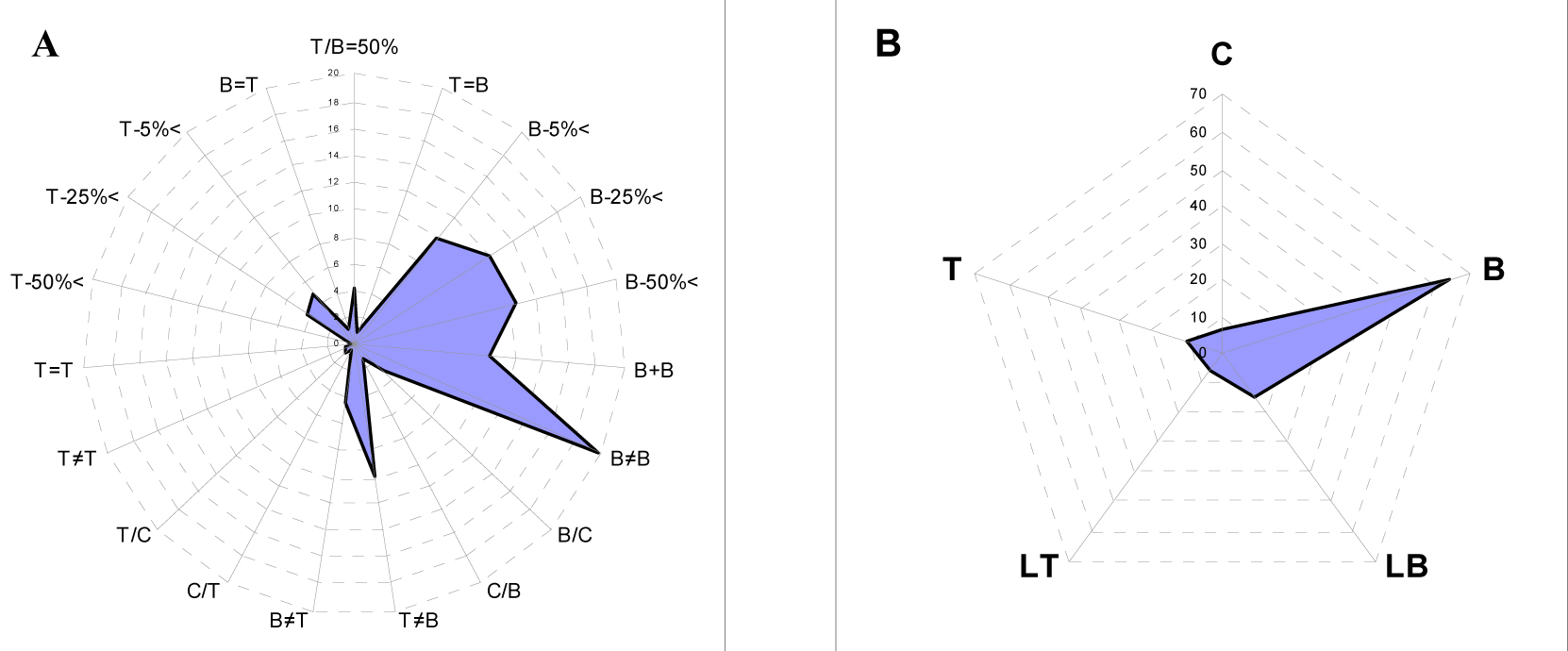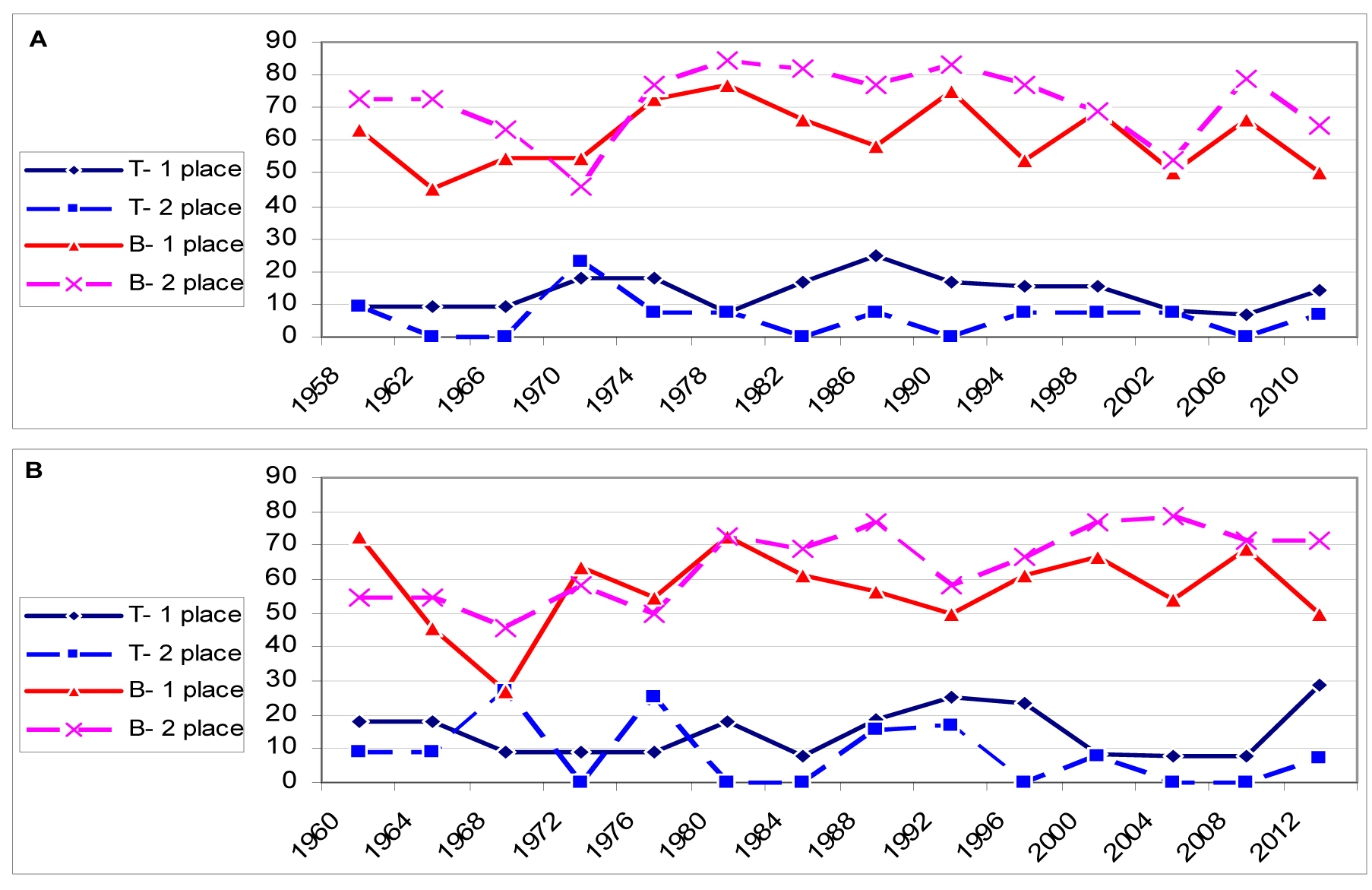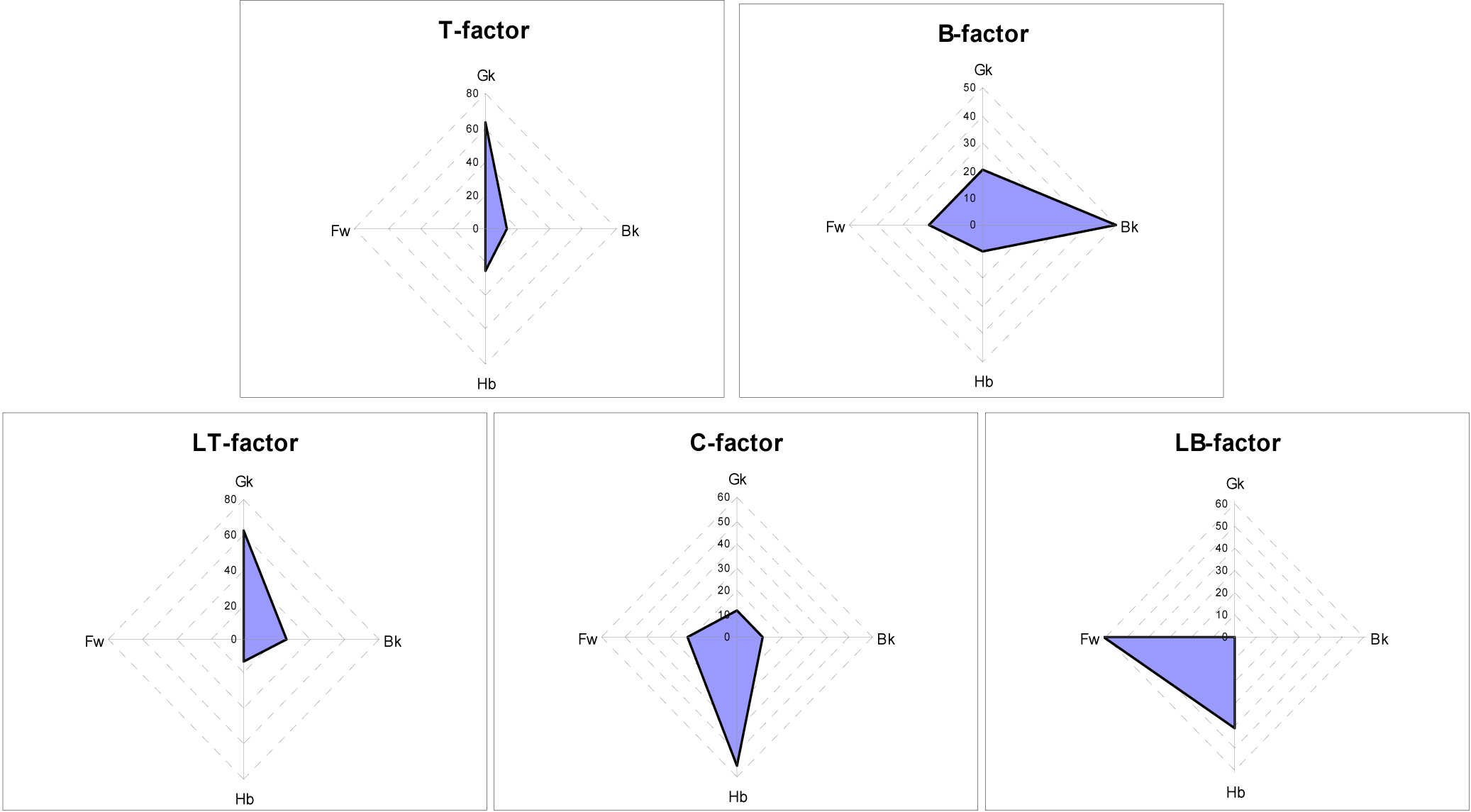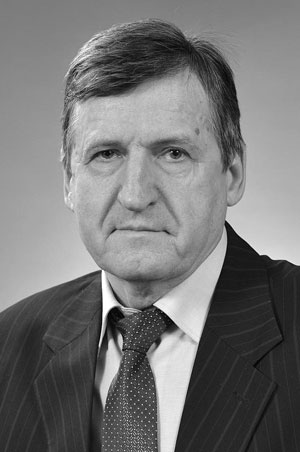Functional and Dynamic Factors of Success of Competitive Performance of Elite Football Players
Фотографии:
ˑ:
V.N. Shelepen’
L.D. Khoda, professor, Dr.Hab.
Technical Institute (branch) of North-Eastern Federal University named after M.K. Ammosov in Neryungri, the Republic of Sakha (Yakutia)
Key words: leading world football teams, World Cup & European Football Championships winners, world level coaches, genotype, functionally dynamic resources, functionally dynamic profiles, functionally dynamic factors, functionally dynamic models.
Introduction. Potential achievements of high sports results suggest the presence of professionally important genotypic functional and dynamic resources (FDR) of an athlete which are necessary for this sport. The big variety of sports activities expands search capabilities of favourable environment for an individual to display his basic (congenital) abilities.
A significant part of our work was devoted to research of high performance in football, search of professionally important functional and dynamic factors (FDR) which determine the success either of teams in general or in game positions (roles) of specific football players [1, 2].
The aim of investigations is to create simple and affordable diagnostic and prognostic tools, which do not require special organizational, technical and financial conditions and enable to remotely (without direct contact with a man as an object of study) identify functional and dynamic model (FDM) of an athlete.
One of the main objectives of our study is to identify the relationship of basic individual and group functional and dynamic factors (FDF) with the success of competitive activity of elite athletes in football.
Materials and methods. The basis of integral FDF determining functional and dynamic profile (FDP) of a sport, a group or an individual athlete, includes either modified elements of the mathematical calculation of the birth date of a person according to Pythagoras, or hypothetical links of the structure of FDF and Aristotle's postulate about political or social, human nature, A.A. Ukhtomsky’s theory of the dominant, the processes of excitation and inhibition of N.E. Vvedensky, functional systems of P.K. Anokhin, Selye’s theory of stress, C. Jung’s theory of on extroversion-introversion, the teachings of Hippocrates, Galen, I.P. Pavlov about temperaments, etc.
The author’s “Software for calculating functional and dynamic resources” (Shelepen’ V.N., Ivanov A.S., 2013) was created for the database automated processing, where all functional and dynamic models, taking into account their functional symmetry and asymmetry (in the author's interpretation), are divided into 19 digital combinations (subgroups), which also are grouped into five FDF.
T-factor: the advantage of even numbers (elementary properties), the presence and number of them: internal - biological vector or bioresources are inhibition of the CNS, energy accumulation, rationality, phlegmatic or melancholic temperament and, as a rule, communicative restraint (passivity), a slight, weak or, often, latent leadership qualities.
B-factor: the advantage of odd numbers (elementary properties), the presence and number of them: external - social - vector or social resources are CNS excitation, energy consumption, emotionality, sanguine or choleric temperament and, as a rule, external (communicative) activity or explicit leadership qualities.
C-factor: zero combining of the potentials “inhibition-excitation”, symmetry and harmony, stability of FDR, balance of odd and even elementary properties, ambivertness.
LT-factor: lability, or extension (asymmetry), combinations of properties of FDR in the direction of the factor T (%). For example, in the first combination of the BDF C-factor or B-factor (%) dominate, while in the second combination T-factor (%) dominates.
LB-factor: lability, or extension (asymmetry), combinations of FDR properties towards B-factor (%). For example, in the first FDR combination C-factor or T-factor (%) dominate, while in the second combination B-factor (%) dominates.
The first phase of the research was devoted to determining the proportions of presented biosocial resources in the human community (Fig. 1a).
The average profile of the conditional functional and dynamic model (UFDM) for the XXth century (the control group (CG) # 1) is 36 525 days or 19 digital combinations. It corresponded to the following parameters of FDR: T-factor was 10 %, B-factor – 64, 4 %, C-factor - 6 %, LT-factor – 5,5 %, LB-factor – 14,1% (Fig. 1b).

Figure 1. Conditional profile of FDR (a) and FDR (b) during the 20th century (36525 days)
The FDR profile on Figure 1b indicates that in the human community of the 20th century the social vector (factor = 64,4 %) greatly dominates. Perhaps, it indicates the social essence of the human nature (according to Aristotle).
The task of the second phase was to identify the relationship of FDR and professional preferences and professional activities.
So there were calculated FDR for the following groups of people: 1050 residents of Neryungri of 1914-1999 years of birth (CG 2); 1041 persons of 1960-1995 years of birth, students of the Technical Institute (b) of NEFU, Neryungri, intra-extramural forms of training (CG 3), and then from this large group of students three groups were allocated, which were formed subject to “Typology of professions by E.A. Klimov”: the control group № 4 consisting of 536 persons of technical specializations of the “person-technology” type; the control group № 5 of the “man - symbol system” type, 320 persons; the control group № 6 - humanitarian group of the “man – man” type, 185 persons; the control group № 7 - the group of student-football players, 54 persons (Tab. 1).
Таble 1. Factor profile of different social and professional groups
|
Groups |
n |
Functional & Dynamic factors (%) |
||||
|
Т |
LТ |
С |
LВ |
В |
||
|
CG 1 |
36525 |
10,0 |
5,5 |
6,0 |
14,1 |
64,4 |
|
CG 2 |
1050 |
10,1 |
3,1 |
5,0 |
17,5 |
64,5 |
|
CG 3 |
1041 |
8,7 |
2,0 |
5,8 |
15,3 |
68,2 |
|
CG 4 |
536 |
8,6 |
2,4 |
6,1 |
15,7 |
67,2 |
|
CG 5 |
320 |
9,7 |
1,2 |
4,7 |
15,6 |
68,8 |
|
CG 6 |
185 |
7,6 |
2,1 |
6,5 |
13,5 |
70,3 |
|
CG 7 |
54 |
11,1 |
0 |
9,3 |
20,4 |
59,2 |
The percentage of FDF is set, which compound the FDP of different social and professional groups. Student-football players have the highest biological resources (T-factor), which is 11,1 %, and the lowest biological resources is in “humanitarian” group of the “man – man” type – 7,6 %. The highest index of the B-factor (social resource) is revealed in the “humanitarian” students group (70,3%) and the lowest one is in the group of football players (59,2%).
On the basis of the obtained data we can assume that all student groups (№2-6) (except for student-football players) especially in the group of “man-man” type, the social vector and emotional status are the most expressed. Perhaps, the natural selection among student-football players occurred in view of greater biological resource and balance of biosocial resources (C-factor), enhancing the body’s adaptation status and functional capacity in relation to the conditions of sports activity.
The third phase was devoted to a more in-depth study of the effective impact of he genotypic FDR on the successful activity of the leading world football teams and elite football players. For this purpose we identified team profiles of FDR of the finals of the world championship (WC) and the UEFA European football championship (EURO) for the last 50 years (28 finals) for the period when the national team of the USSR began to take part in the World Cup (1958) and the European (1960) Championships (Fig. 2). The main stable and significant differences between the first and the second places were established in the areas of factors of T and B (Fig. 2).

Figure 2. The dynamics of the correlation of factors T and B in group FDP of teams-finalists
of the World Cup (A) and European (B) Championships
Starting with the finals of the World Cup 1974 (in 90% of cases) and with the European Championship 1984 (in 100% of cases) and in the present time, the advantage of the resources which form the B-factor (social vector, release energy, excitement) for defeated teams is fundamental. The advantage of resources that form factor T (biological vector, energy accumulation, rationality, emotional stability) amounted to 80% and 90% for the winners of the World Cup and the EC respectively.
The top three of winners of the last World Cup 2010 in South Africa demonstrates that, in addition to appropriate skills, and sufficient motivation, players with a higher level of values of the T-factor and a lower level of the B-factor are of great importance (Fig 3). In addition, the World Champion of 2010, Spain, has a significant advantage (21,5%) to the silver and bronze winners of the World Cup (Holland and Germany) within the availability of resources, components of the C-factor (stability of FDR, ambivertness, symmetry and harmony of elementary properties).
If to compare FDM of the national football team of Spain of the 2010 sample with UFDM of the 20th century, the percentage of football players with the dominant C-factor in the composition of the Spanish national team exceeds 4,8 times as much than UFDM (Tab. 2).
Таble 2. Group FDF of the World Cup 2010 (South Africa) winners
|
Place |
Factors |
||||
|
Т |
L-Т |
С |
L-В |
В |
|
|
1 place |
14,3 |
0 |
28,6 |
7,1 |
50,0 |
|
2 place |
7,1 |
7,1 |
7,1 |
14,4 |
64,3 |
|
3 place |
0 |
7,1 |
7,1 |
7,1 |
78,7 |
The significant contribution of the Spanish Championship in the formation of the national team, which is a pacesetter for the modern trends of world football, is in the fact that in the depths of the championship those players whose basic FDR models correspond to the model characteristics of the team’s game are naturally selected. Players with the more stable nervous system can withstand not only high physical loads, but the total control of the ball, generate profitable game situations patiently, rationally and systematically.
The same above-mentioned trends in the competitiveness of group FDP, especially in the last five years, are preserved in the Champions League (CL), UEFA (Tаb. 3).
Таble 3. Group FDF of the UEFA Champions League finalists of 2009-2013
|
Place |
Factors |
||||
|
Т |
L-Т |
С |
L-В |
В |
|
|
1 place |
15,0 |
4,5 |
5,9 |
16,4 |
58,2 |
|
2 place |
10,6 |
3,1 |
6,0 |
4,9 |
75,4 |
In the finals of the UEFA Champions League 2012-2013, with equal T-factors, winners Chelsea (England) and Bayern Munich (Germany) yielded to their opponents Bayern (2012) and German Borussia (2013) in the components of B-factors by 21,3% and 7,7% respectively. In the UEFA Champions League final 2011 the winner Barcelona (Spain) surpassed its rival Manchester United (England) in the components of the T-factor by 20,9% and yielded in the components of the B-factor by 33,5%.
In addition to team profiles, we studied group FDR in nine groups of elite football players (4614 in total) to determine the model characteristics of game positions. They are members of the national Championships of England (571 persons), Germany (520 persons), Spain (475 persons), Italy (535 persons), France (521 persons), RFPL (388 persons, winners of all 14 EC (294 persons), all the winners of 14 EC (294 persons), participants of EURO-2012 (477 persons), participants of the Champions League 2010/11 (833 persons).
FDR vectors in all examined groups have the following directions (Fig. 3).

Fig. 3. Grouping of FDM factors considering playing positions (roles) of elite football players
(4614 persons)
The T-factor is mostly displayed, first of all, for goalkeepers in five groups of nine (62,5%) and expressed for midfielders (25%). Probably a higher concentration of intro-rational resources, forming the T-factor for goalkeepers, enables them to be more emotionally stable and gives explosive physical strength, but the less displayed T-factor for midfielders improves their speed-strength endurance and provides the stable emotional background.
The B-factor is mostly displayed among fullbacks (50%). Thanks to higher CNS excitation fullbacks are more attentive and actively aggressive in the opposition.
The LT-factor is also mostly displayed among goalkeepers (62,5%) and expressed among fullbacks (25%). Extension of goalkeepers’ properties to the side of the T-factor increases its value, but helps them to be more flexible in the manifestation of these properties.
The C-factor is most expressed among midfielders (55,6%) and expressed among forwards (22,2%). Most likely, the resources, forming the T-factor give to midfielders psychophysical stability and extend the range of use of opposite, ambivert T and B-factors.
The LB-factor is mostly displayed among forwards (60%) and expressed among midfielders (40%). The extension of properties in the direction of CNS excitation leads to an increase of extra-emotional tonus, energy release and helps forwards to show their energy and speed-strength status simultaneously. The same resources, but slightly less are displayed among midfielders, enabling them to preserve their energy and speed-strength statuses longer than forwards.
It should be noted that combinations of FDR compounding T and LT- factors, are lacking among all studied forwards (963 persons) and combinations of the LB-factor are lacking among goalkeepers (523 of people) and fullbacks (1462 people).
Identifying the dominant FDF regarding game positions raises the question of competitiveness of FDF in the direct confrontation in the conditions of competitive activity. An analysis of the finals of the UEFA Champions League 2000-2013 was made for this purpose (Tab. 4).
Таble 4. FDF group profiles of positions (roles) of the finals of the UEFA Champions League 2000-2013
|
Factors |
Positions |
|||||||
|
Goalkeepers |
Fullbacks |
Half-backs |
Forwards |
|||||
|
1 place |
2 place |
1 place |
2 place |
1 place |
2 place |
1 place |
2 place |
|
|
Т |
33,3 |
0 |
13,0 |
8,6 |
16,4 |
14,1 |
0 |
7,7 |
|
L-Т |
0 |
13,3 |
3,0 |
1,7 |
2,8 |
2,6 |
0 |
7,7 |
|
С |
0 |
6,7 |
4,3 |
5,2 |
9,6 |
9,0 |
8,3 |
10,2 |
|
L-В |
6,7 |
13,3 |
13,0 |
10,4 |
20,5 |
17,9 |
22,2 |
7,7 |
|
В |
60,0 |
66,7 |
66,7 |
74,1 |
50,7 |
56,4 |
69,5 |
66,7 |
It is interesting to note that a dominant advantage of the T-factor was displayed for CL winner goalkeepers whereas this factor is lacking among their opponents-goalkeepers.
It is enough to give as an example outstanding goalkeepers of the past and present - Lev Yashin (the first EC-1960 and the single goalkeeper - the world's best player prize winner 1963, the «Golden Ball»), active World and European Champions, goalkeepers of the national team of Spain Iker Casillas and Victor Valdes. Their personal basic combinations of FDR with the dominant T-factor are as similar as possible.
It should be particularly noted that according to UFDM, in the 20th century there are about 10% of people with a dominant T-factor and 4,2% of those with such a combination of FDR like of L. Yashin, I. Casillas and V. Valdes which is eight times more than UFDM (Fig. 1, Tab. 1).
Among four play groups the level of the B-factor of the UEFA Champions League winners goalkeepers and halfbacks is lower than in the UFDM (64,4%) of halfbacks and forwards. It confirms a higher level of psychological and emotional stability for goalkeepers and psychomotor endurance for midfield players.
The CL winners - forwards surpass forwards, their rivals, in the presence of the B-factor, which contributes to maintaining the level of attention concentration, increases the extra-emotional tone, but it reduces the psycho-emotional and psychomotor resistance, accelerates functional recovery. However, the motor volume of game load for modern forwards is usually lower than for midfield players and outer backs, so increased concentration of the B-factor is not a hindrance for them.
At the same time, the concentration of the B-factor (74,1%) of fullbacks, who lost in the UEFA Champions League final should be, most likely, recognized excessive. Excessive excitement of a fullback can cause a converse effect. For example, in the control group, consisting of 4614 elite football-players (Fig. 3), particularly fullbacks have the most expressed B-factor (62,8%), but it is still lower than in fullbacks in Table 4.
As it is seen from the material above, high concentration (relative to UFDM and their rivals) of biological, intro-rational resources (the factors T, and partly C and L-T) is required from winning teams in modern football. However, if to consider the peculiarities of some FDR, usually the leaders are those players whose vector of personal FDP is directed towards social and extra-emotional resources (Tаb. 5).
Таble 5. FDF profiles of outstanding players of the world, the USSR and Russia
|
Groups |
Period |
Factors |
||||
|
Т |
L-Т |
С |
L-В |
В |
||
|
The Century best goalscorers |
1889-2012 |
7,7 |
11,5 |
0 |
7,7 |
73,1 |
|
Golden Ball Winners |
1956-2013 |
13,5 |
5,1 |
0 |
13,5 |
67,9 |
|
G. Fedotov’s Club of goalscorers |
1967-2013 |
11 |
4,1 |
9,6 |
6,8 |
68,5 |
|
Player of the Year in Russia |
1992-2013 |
12 |
0 |
12 |
8 |
68 |
After all, football is a mass social phenomenon which, apart from everything, is a powerful theatrical action, conflict show which is oriented to spectacular expressiveness. Athletes have to have contact not only with an opponent, but with judges, assistants, spectators, fans and mass media.
The main “body” of the team should be made in accordance with the team’s game model, of players with specific combinations of basic FDR. Playing activity of some players takes place without special, external effects, and its usefulness is visible only to a narrow circle of specialists. They are often referred to those who “pull the piano” or “bring the projectiles”. Activities of others contain the attributes of theatricality, and if it is backed with goals, not only with effective but also efficient technical elements, such performers are usually noted as those who “play the piano”. Therefore, the extra-emotional vector has a special importance in those sports with scores for artistry: for example, national champions of the Olympic games (COP) in figure skating have the B-factor of the 75% level. Curiously, even in those sports where, apparently, there are no formal requirements to artistry (for example, COP throwers) the extra-emotional level is extremely high – 90,9%. Of course, that in addition to the anthropometric parameters, a powerful psycho-emotional splash plays the fundamental role.
The description of genotypic factors of success in football will be incomplete if coachers of football teams are left unaddressed (Tаb. 6).
Таble 6. FDF profiles of head coaches of WC, EC, UEFA Champions League (2000-2013)
|
Factors |
Tournaments |
|||||
|
WC finalists (38) |
EC finalists (28) |
UEFA CL finalists (26) |
||||
|
1 place |
2 place |
1 place |
2 place |
1 place |
2 place |
|
|
Т |
26,3 |
15,0 |
7,1 |
7,1 |
14,3 |
19,0 |
|
L-Т |
10,5 |
5,0 |
7,1 |
7,1 |
0 |
0 |
|
С |
5,3 |
0 |
0 |
14,3 |
0 |
0 |
|
L-В |
5,3 |
15,0 |
7,1 |
14,3 |
19,0 |
19,0 |
|
В |
52,6 |
65,0 |
78,7 |
57,2 |
66,7 |
61,9 |
In general, coaches of the world level are somehow different from their European colleagues. They value the same factors as teams they head: the factor T from the winners of the World Cup is 2,6 times higher than the UFDM, so the B-factor is 11,8% lower. Those trainers who work at the European level have a higher social value of the social, extra-emotional factor than their opponents in the finals, and 14,3% higher than the UFDM (EC - 78,7%). The European social environment probably needs better social resources.
Conclusions. According to the data resulting from the mathematical processing, all studied socio-professional groups have a more dominating factor reflecting the social vector of a man.
The findings of the research prove that not only high physical and technical-tactical components, but also the relevant functional-dynamic resources of performers are required to achieve high results in sport.
In the studies the dominating factors of functional-dynamic models of football players when choosing playing positions (roles) of the leading players in the world are mathematically established.
The designed technique that does not require special organizational, technological and financial conditions, enables to determine athletes’ functional-dynamic resources, functional differences in players’ roles, to form the model of team play, which helps to define it as an element of existing diagnostic tools in the system of sports qualification.
References
- Shelepen’, V.N., Khoda, L.D. Technology of analysis and forecasting of sports achievements of national football teams based on the periodicity of the historical process and the typology of national peculiarities, 2009.Teoriya i praktika fizicheskoy kul’tury, - 2009. № 3. - P.73-77. (In Russian)
- Shelepen’, V.N., Khoda, L.D. Functional and dynamic models of basic resources of football players. Physical culture and sport in the modern society: Proceedings of the All-Russia Scien. Conference, Mrach, 28-29 2013; ed. by S.S. Dobrovol’sky and G.S. Kham. – Khabarovsk: publ. h-se of FESTU, 2013. - 397 P. –P. 359-365. (In Russian)
Corresponding author: lkhoda@yandex.ru


